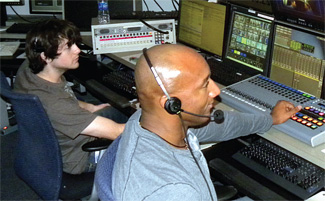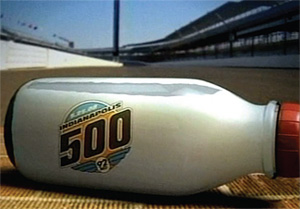Putting the 'Wow' Factor in Sports Edits
TORONTO
After a while, TV sports video editors can find themselves in a rut. Day in and day out, the video looks the same; be it the mandatory highlight reel or an interview with a local athletic star.
So is there anything new in the world of sports video editing? Actually, yes: Innovative broadcasters have come with some new twists to this art; twists that they shared with TV Technology.
WEB STRATEGY
Like other member stations of Cox Broadcasting, ABC affiliate WFTV-9 in Orlando, Fla., is equipped with a Grass Valley Ignite master control/newsroom automation system: linked to a MediaFUSE content repurposing system.

At WFTV, Andrew Brooks (R) and Taijuan Vann edit sports content on a Grass Valley Ignite. "We were the last of the group to go with Ignite, and thus learned a lot from our sisters," says John Demshock, WFTV's director of engineering. "So when GV was looking for a 'pilot' partner for their Web-centric Ignite expansion, they approached us. Essentially, this Ignite application allows a producer to mark up a rundown for Web videos as well as, or in addition to, the 'regular' news rundown."
Here's the cool part: "As the rundown is executed through Ignite, MediaFUSE automatically builds a series of file-based clips that can be published either directly to the Web or through a service like Internet Broadcast Corp," Demshock said.
WFTV's sports department uses the system to publish expanded coverage of the stories aired on TV. "We simply add the expanded sports segment to the end of the late news rundown," he said. "After the on-air part of the show ends, they just keep going an extra 15 or 20 minutes so that MediaFUSE produces clips that are published to the Web as expanded coverage."
For viewers, the result is a selection of "pick and choose" clips, which works well for high school sports stories that are too niche for broadcast, but not for the Web. The best part is that "this expanded sports material is done with no additional staff, and coordinated by the sports department," Demshock said. "Needless to say, they love it because they get all the 'air time' they want."
CREATIVE EFFECTS
As an all-sports broadcaster, ESPN tries particularly hard to stay out of the sports editing rut. One way it does this is by employing creative graphics to punch up teases, introductions, bridges, bumpers and extros.
"We want our transitions to grab the viewer and hold them, using the 'wow factor," said ESPN Senior Coordinating producer Jill Frederickson. "For instance, for the 2008 Indianapolis 500 teaser, our New York effects firm Mantra created a milk bottle—emblematic of the race—sucking in a huge tornado over the race track, ending up with it spinning on the bricks."
On an ongoing basis, ESPN makes a point of having preproduced SFX intros, bumpers, transitions and extros ready in its control room, so that they can add sizzle to spots during their live broadcasts. They also preproduce specialized titles/
sequences for major sports stars—including video of the star off the track/field—that can be used as needed. These high-end elements allow dailies such as SportsCenter to maintain a compelling look on air, rather than just dropping in a few supers listing the player's name and team.
Although ESPN's SFX are top-of-the-line, Frederickson says much of the network's approach can be adapted by local TV sportscasts. "The key is to have the SFX-enhanced videos ready to go; whether in master control or the editing room," she said. "By doing this work before—either in-house or through an third-party SFX company—you'll have it on hand to jazz up your regular features. It will make your content look far more polished, professional and distinctive. People will know that they're watching your channel."
MAKE A VIDEO BED
WSB-2, the ABC affiliate in Atlanta, knows how to make its athlete profiles visually arresting. The reason: Rather than just mix head shots with action clips, WSB uses "video beds" onto which the headshots and action clips are overlaid into separate video windows.

For ESPN's coverage of the Indy 500, New York effects firm Mantra created a milk bottle--emblematic of the race--sucking in a huge tornado over the race track, ending up with it spinning on the bricks. To create a video bed, "You take a layer of colored video, then slow-mo and resize a subject dissolved in the background," explains WSB News Operations Manager Don Bailey. "The video is partially dissolved, so that you make it out but it doesn't dominate the screen. You can then place video boxes over this background."
Because one of the video windows is used for action sequences—which can be zoomed out to take up the whole screen as desired, then zoomed back—Bailey prefers not to use action sequences in the video bed itself. "Instead, I look for something distinctive, like the player's helmet or a close-up on his eyes looking intense."
WSB produces all of this on an Avid News Cutter NLE; proving that such a seemingly high-end effect is within reach of most TV sports departments. "It provides our coverage of local college and high school athletes with the kind of polish you typically see on the networks," Bailey said.
LOCAL STARS MAKE GOOD
One of the ultimate flaws of sports highlight reels is their sameness. They are usually nothing more than sequential summaries of a given game, with the clips exclusively focused on major plays.
Of course, viewers expect this when they watch TV sports. But they also want to see something different, like the ongoing progress of a local star now playing in the majors.
To provide such coverage economically, CBS affiliate WRGB-6 in Albany, N.Y., regularly records major games in their entirety. "The game video is taken from a digital cable box tuned to an HD channel and configured for SD component output," said Fred Lass, WGRB's director of engineering. "The component signal and analog audio is fed to an Ensemble Brighteye 75 to generate a 16:9 SD SDI signal with embedded audio. The downconversion from HD to SD is done by the cable set-top box."
The game video is recorded on two channels of WRGB's Nexio file server. Typically, someone keeps an eye on the game in real-time, noting down the times when a local star is seen on-camera. When the game is over, putting together a quick highlight reel of the star's appearances is quick and easy. The result is a personalized feature that the sportscast can trumpet during pre-news promos, and as part of its positioning in the market: "We don't just show you the highlights. We show you what our hometown stars are doing in the Big Time!"
"We find that this kind of feature is quite easy to produce," Lass notes. "We don't even have to store the footage on the Nexio; we could just pull it off the cable box's HD-PVR in rough clips, then cut it down on our nonlinear editor. But having it on the Nexio makes assembling these features very simple and fast—and our viewers really like them!"
The professional video industry's #1 source for news, trends and product and tech information. Sign up below.
James Careless is an award-winning journalist who has written for TV Technology since the 1990s. He has covered HDTV from the days of the six competing HDTV formats that led to the 1993 Grand Alliance, and onwards through ATSC 3.0 and OTT. He also writes for Radio World, along with other publications in aerospace, defense, public safety, streaming media, plus the amusement park industry for something different.

